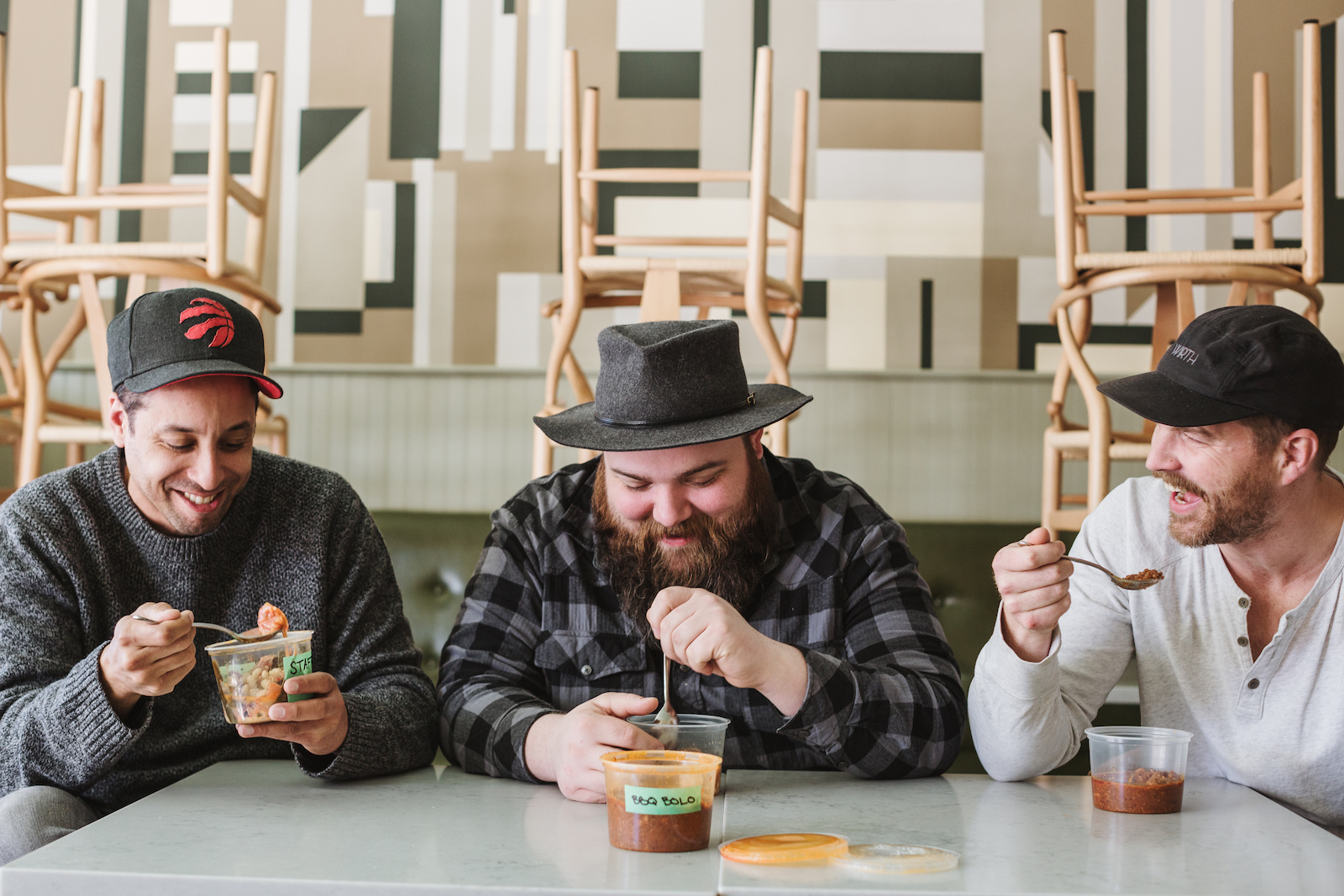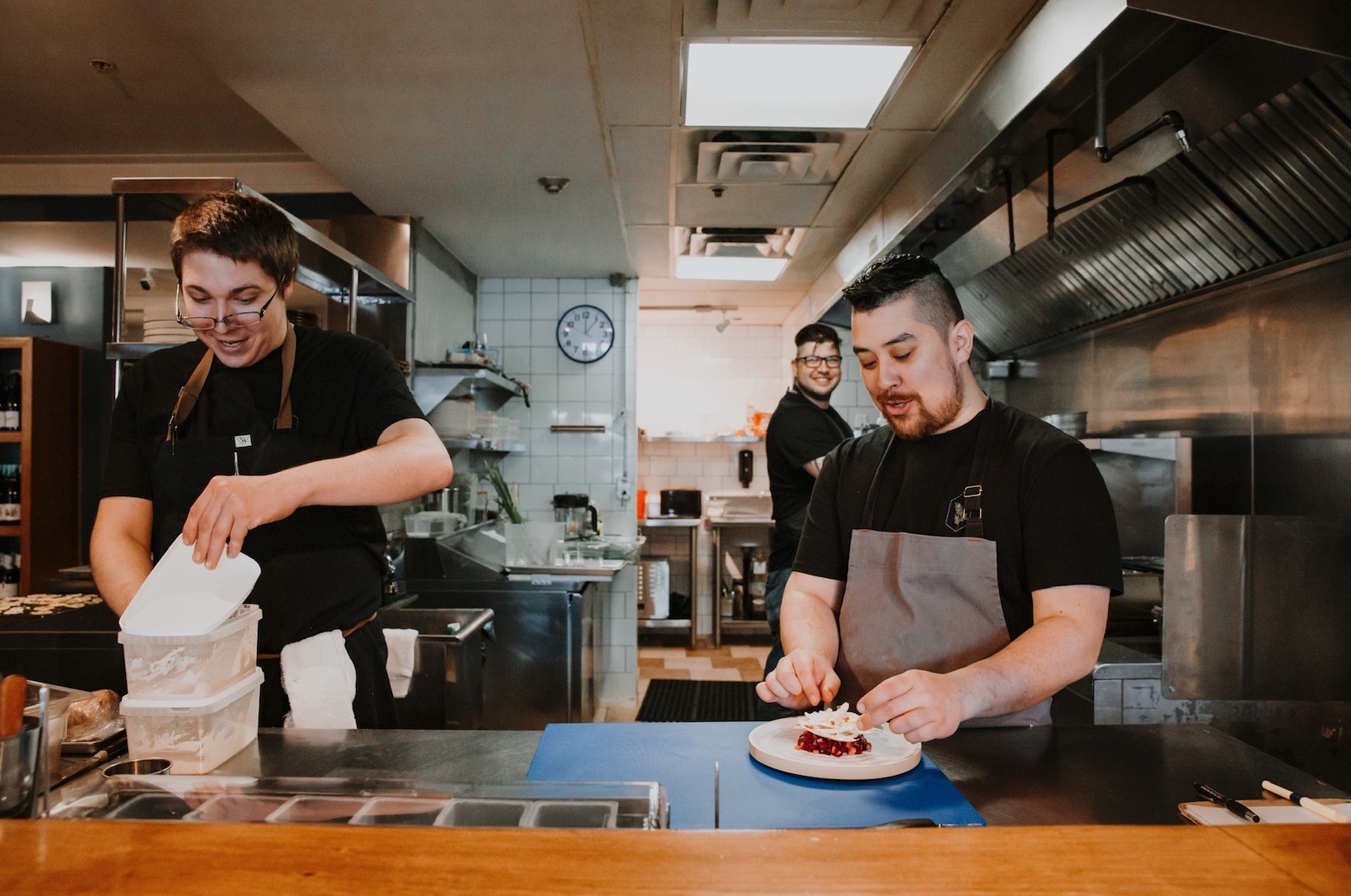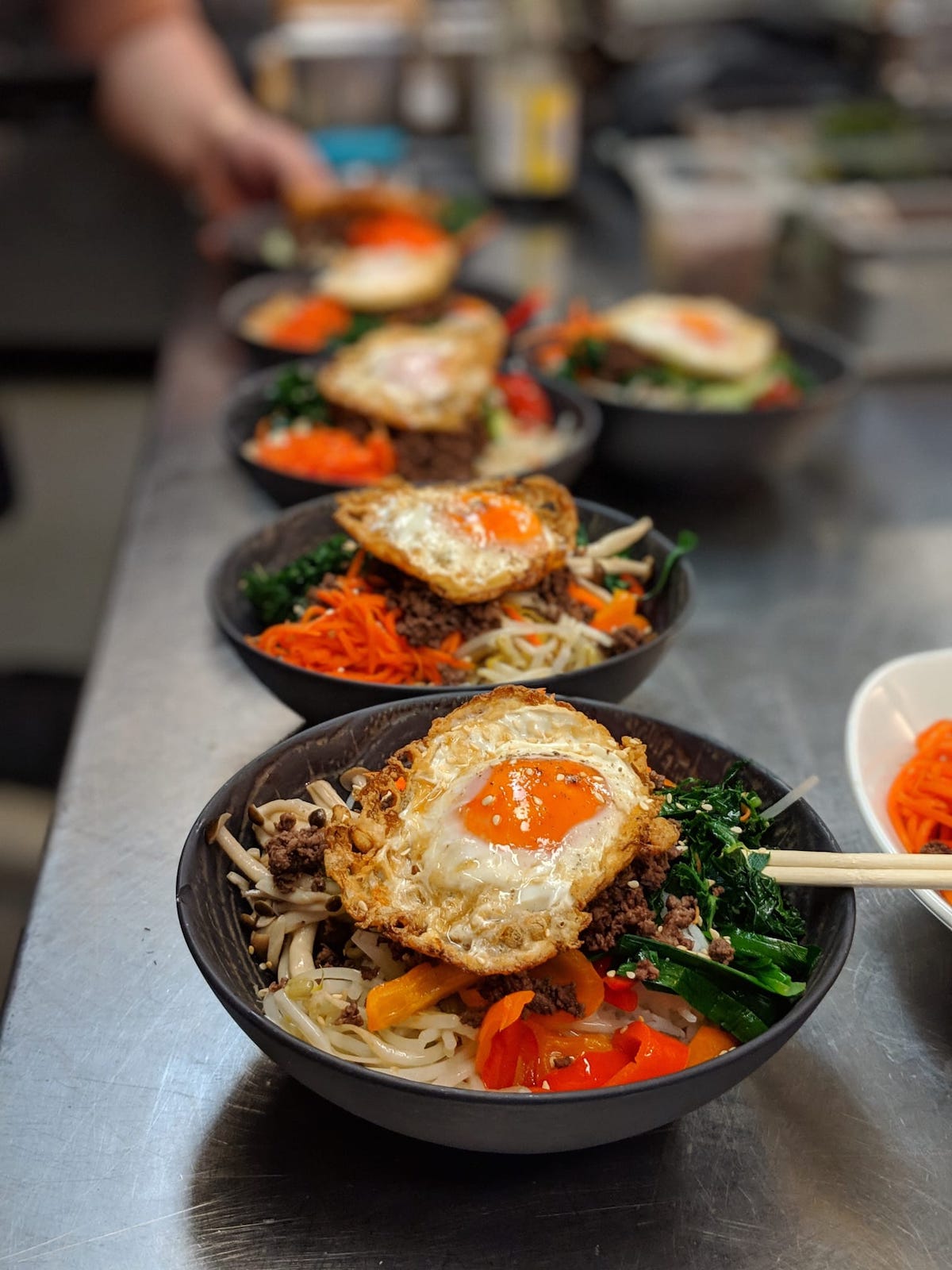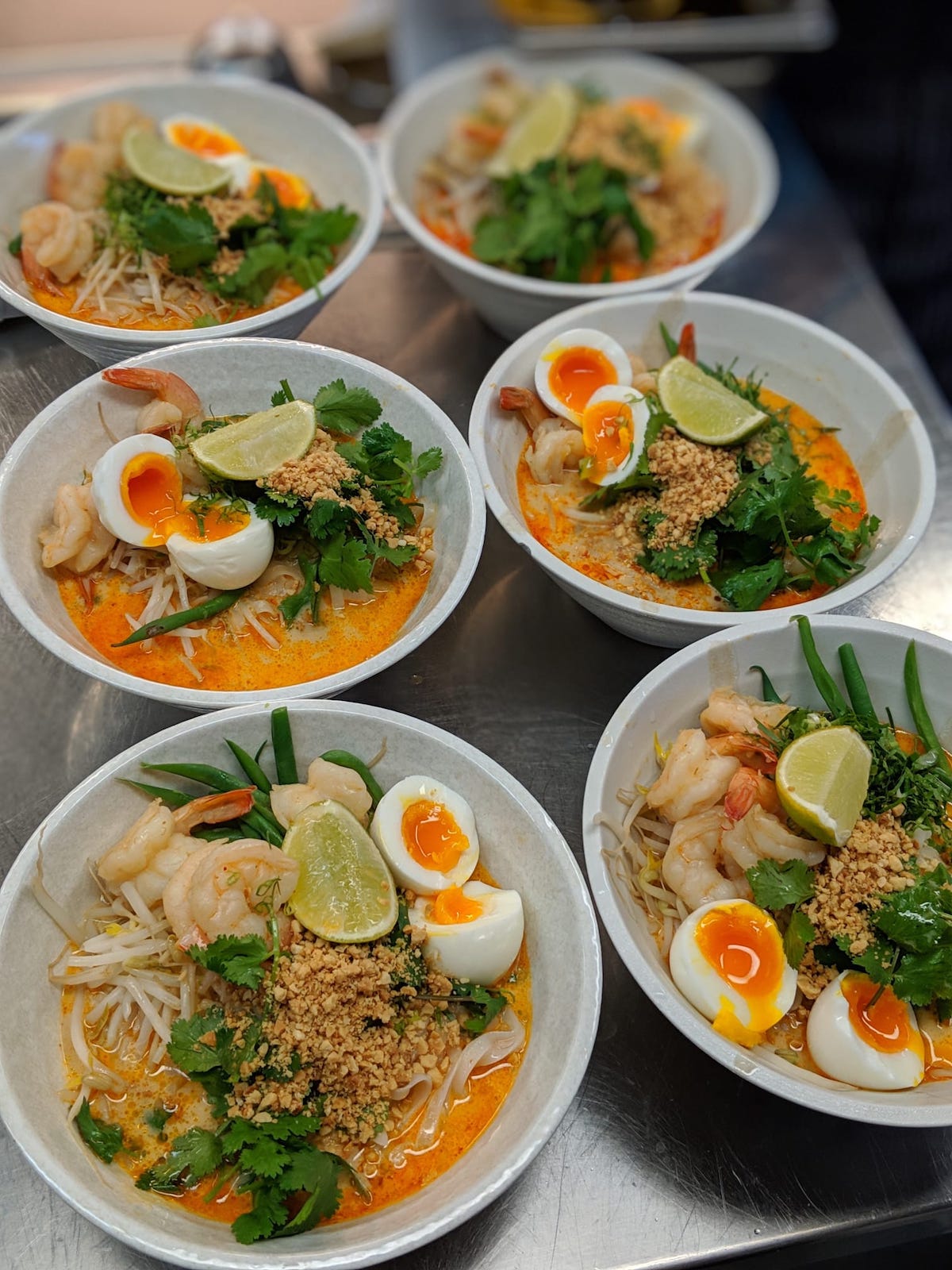Before the flurry of dinner service begins, the Mackenzie Room staff share a meal. Chef de cuisine Josh Stel places sloppy joes on the pass along with cutlery and plates. Cooks and servers help themselves then migrate to different areas of the dining room. Some chat around a table, while others congregate at the bar. One or two head outside for fresh air and time to themselves, readying for the night ahead.

Photo by Katie Cross Photography courtesy of Collective Hospitality.
For Antonio Cayonne, director of operations at Collective Hospitality, these dinners—called staff or family meals—have been a constant over his twenty-plus years in the industry. At one Toronto restaurant, everyone gathered at a harvest table and feasted on heaping plates of food as they caught up with one another. At Collective Hospitality, which runs The Mackenzie Room, Say Mercy!, and Collective Goods, staff meals are more informal. The cooks take turns preparing simple comfort food, such as chicken curry or bánh mì, and staff choose how they want to socialize on any given night.
Cayonne says staff meals serve many purposes. Members of the team require a full belly before a demanding shift, but breaking bread together also has other benefits that are less tangible but perhaps even more important. Once service begins, staff have little time to chat, so a family meal can be one of the few occasions for getting to know colleagues. He says, “It’s a time to check in with one another over a meal to see how the day has been, to help people reset, if that’s what they’re in need of, or to tell a great story. There is a really important mental health and emotional aspect to it.”
While staff meals are nothing new, Cayonne feels that, if done right, they can reflect a positive shift in how restaurants treat their staff. “The idea of community, the idea of trying our absolute best to take care of each other, to show up with integrity, those are chief among our values.”

Photo by Katie Cross Photography courtesy of Collective Hospitality.
These commitments were tested when Collective Hospitality had to lay off staff during the early days of the pandemic. The company’s response was the Staff Meal Initiative, which at first involved repurposing excess ingredients to make meals for former staff. However, upon realizing that restaurant workers were not alone in food insecurity, Collective Hospitality expanded the initiative and started selling inexpensive hearty meals, such as lasagna and shepherd’s pie, to the public and collecting donations for groups in need. Other establishments hopped on board, generating optimism during a difficult period. Cayonne says, “The question for us was how to remain hospitable when the rooms that we typically host our hospitality within had closed.”
The success of the initiative speaks to the power of collective experience. Colin Uyeda, co-owner and chef of Folke Restaurant, feels family meals generate a sense of community, one that permeates all aspects of the organization. At Folke, staff are all paid the same salary, and gratuities are included in the menu prices. “There’s a lot of discrimination in tipping so I wanted everyone to be equal,” Uyeda says. It’s also important to him that staff are compensated like professionals, with benefits and a discretionary spending account for things like health expenses or RRSP contributions. In the day-to-day operations, he encourages everyone to work as one team, even getting cooks to deliver food to the tables, to blur the front and back of house.
Uyeda has enjoyed staff meals in countries as far-flung as Australia, Japan, and Denmark, and closer to home at restaurants such as Pilgrimme (on Galiano Island) and Kissa Tanto. While some places have restrictions on who can eat or offer just modest discounts on food, Uyeda wants to cultivate a different type of workplace. “I didn’t want it to be like that ever.”

Photo courtesy of Folke Restaurant.
Instead, he likens staff meals to the big family dinners he had growing up where everyone dug into delicious food, passing plates around and chatting. For young cooks, it can be a low-stakes way to build confidence and practise techniques, but, for Uyeda, it’s mostly about creating dishes, such as ramen, focaccia sandwiches, and rustic pastas, that make colleagues feel cosseted. He says, “Staff meal doesn’t have to be fancy but should be tasty and satisfying.”
About an hour before Folke opens, the team decompresses while eating. Uyeda likes cooking the meal because it prioritizes staff needs. “I usually ask someone what they want, and I cook that,” he says. Recently it was someone’s birthday, and Uyeda was happy to fulfill their yearning for tofu katsudon. Co-owner and pastry chef Pricilla Deo bakes cakes to celebrate milestones. Especially in an industry that demands long hours away from loved ones, these gestures are meaningful, creating a sense of belonging at work.

Photo by Mike Tuangkitkun courtesy of Maenam.
Angus An has fond memories of the staff meal at Toqué in Montreal. Each kitchen station contributed a dish for a multi-course dinner. As much as An relished the eating, he found even more value in bonding with his colleagues: “It’s an important ritual. It’s the only time you and your coworkers can have a chat with each other as normal humans as opposed to fellow workers.”
He looked forward to cooking staff meals, sometimes showcasing favourites from his Taiwanese heritage, other times making dishes such as meatloaf from offcuts. He says, “We were often encouraged to be creative with what would eventually become waste if we didn’t use it, but we made it into something delicious and beautiful.”
Now a restaurateur himself, An holds regular family meals that focus on self-care and nourishment at his many establishments, including Maenam. As a young cook he often powered through hunger, burning himself out. He also worked at restaurants where cooks resorted to wolfing down scraps sandwiched between Wonder Bread when they were on shift. He says, “That didn’t give me a good experience. If you don’t believe in feeding your cooks, how can you do a good job feeding your customers?”
Although staff meals at Maenam aren’t as elaborate as the ones at Toqué, dishes such as braised beef noodle soup, fried rice, and southern Thai fried chicken ensure that everyone is well fed. When staff are too busy to whip up a family meal, An treats them to pizza or sandwiches from other restaurants. He says, “Sometimes, if I’m having coffee for a meeting, I’ll buy a six-pack of doughnuts for the cooks. I think those little things are appreciated.”

Photo by Mike Tuangkitkun courtesy of Maenam.
An believes family meals can be restorative compared to the isolation of staff eating alone while scrolling on social media. He organizes activities throughout the year to foster further camaraderie. It’s become a tradition for his staff to hike the Grouse Grind and then feast on dim sum while comparing finish times. And because An is willing to go the extra mile for his team, they feel more connected to the restaurant and stay longer.
More can always be done, but An tries his best to create a positive work environment where staff feel like family. “Mostly we try to be fair in terms of the demands we make and try to respect them as human beings,” he says. Ultimately, treating staff well can be as simple and as necessary as a shared meal.
Read more local food and drink stories.









